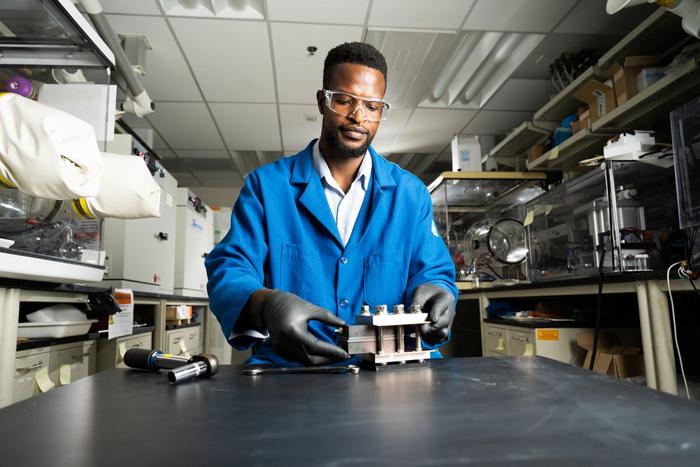Iron-based flow batteries have been around for decades, and some are now commercially available. While vanadium redox flow batteries are the most mature and popular technology in the family of flow batteries, adopting iron complexes as the active materials of choice could alleviate the challenges associated with the supply chain, particularly in the context of large-scale energy storage applications.
A new battery designed by researchers at the Department of Energy’s Pacific Northwest National Laboratory (PNNL) is said to provide a pathway to a safe, economical, water-based, flow battery made with abundant materials, while also offering strong performances.
The researchers have developed a liquid chemical formula that combines charged iron with a neutral-pH phosphate-based liquid electrolyte. They used the chemical called nitrogenous triphosphonate, nitrilotri-methylphosphonic acid (NTMPA), which is commercially available in industrial quantities and typically used to inhibit corrosion in water treatment plants.
Phosphonates, including NTMPA, are a broad chemical family based on the element phosphorus. Many phosphonates dissolve well in water and are nontoxic chemicals used in fertilizers and detergents, among other uses.
“We were looking for an electrolyte that could bind and store charged iron in a liquid complex at room temperature and mild operating conditions with neutral pH,” said senior author Guosheng Li, a senior scientist at PNNL who leads materials development for rechargeable energy storage devices. “We are motivated to develop battery materials that are Earth-abundant and can be sourced domestically.”
Popular content
The researchers reported that their lab-scale, iron-based battery exhibited remarkable cycling stability over one thousand consecutive charging cycles, while maintaining 98.7% of its capacity. For comparison, previous studies of similar iron-based batteries reported degradation of the charge capacity two orders of magnitude higher, over fewer charging cycles. The new battery also demonstrated high Coulombic efficiency and energy efficiency near 100% and 87%, respectively, they said.
“A BESS facility using the chemistry similar to what we have developed here would have the advantage of operating in water at neutral pH,” said Aaron Hollas, a study author and team leader in PNNL’s Battery Materials and Systems Group. “In addition, our system uses commercially available reagents that haven’t been previously investigated for use in flow batteries.”
The research team reported that their initial design can reach energy density up to 9 Wh/L, lagging behind commercialized vanadium-based systems that are more than twice as energy dense, at 25 Wh/L. Their next move is to improve the battery’s voltage output and electrolyte concentration, which will help to increase the energy density.
Their results were discussed in the study “Phosphonate-based iron complex for a cost-effective and long cycling aqueous iron redox flow battery,” published in nature communications.
This content is protected by copyright and may not be reused. If you want to cooperate with us and would like to reuse some of our content, please contact: editors@pv-magazine.com.



1 comment
By submitting this form you agree to pv magazine using your data for the purposes of publishing your comment.
Your personal data will only be disclosed or otherwise transmitted to third parties for the purposes of spam filtering or if this is necessary for technical maintenance of the website. Any other transfer to third parties will not take place unless this is justified on the basis of applicable data protection regulations or if pv magazine is legally obliged to do so.
You may revoke this consent at any time with effect for the future, in which case your personal data will be deleted immediately. Otherwise, your data will be deleted if pv magazine has processed your request or the purpose of data storage is fulfilled.
Further information on data privacy can be found in our Data Protection Policy.